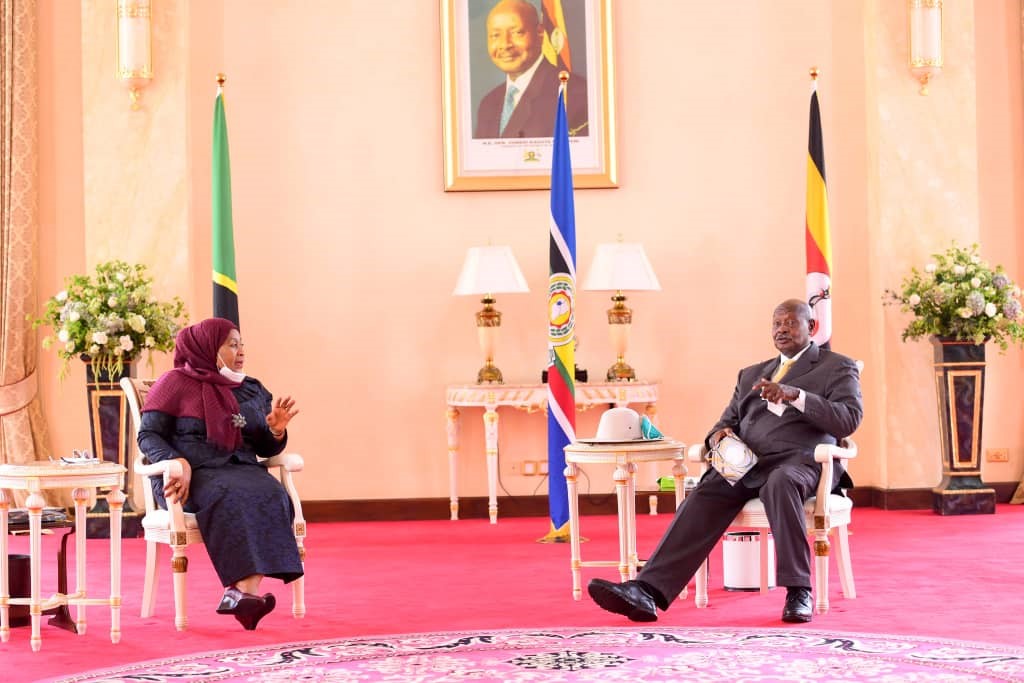Total’s oil drilling rig at work
Oil and gas exploration and production giant, TotalEnergies Uganda is currently executing two huge oil projects, Tilenga and EACOP.
The Tilenga project is being constructed in the North Albertine region of Western Uganda.
This area is one of Africa’s most important areas for biodiversity. This is because the region is home to several iconic species, including the Nubian Giraffe, Lion, African Elephant, Uganda Kob, Lelwel Hartebeest and Eastern Chimpanzee. It also hosts close to 450 different bird species including Uganda’s national bird – the Grey Crowned Crane.
Therefore, protecting biodiversity in Murchison Falls Protected Area and the surrounding landscape has been a key priority for TotalEnergies since the early planning stages of the Tilenga project. The North Albertine Region has faced considerable human induced pressures for many years, most of which existed prior to the discovery of oil in 2006.
These pressures include snare poaching, deforestation and habitat conversion for agriculture and cattle rearing.
In addition to these long standing issues, recent activities for oil and gas development and associated infrastructure, including national roads, have added to the challenges in this highly sensitive area. Operating in the area requires a deep understanding of the complex and dynamic factors that can lead to biodiversity loss.
On this, TotalEnergies’s landscape based approach, has been developed from international and national best practice standards and ensures its net positive impact commitment for the development is fully integrated and complements existing conservation and community development efforts in the region.
Through active stewardship and collaboration with stakeholders, TEP Uganda aims to align with broader conservation targets, national strategic action plans (such as National Biodiversity Strategy and Action Plan1), regional development objectives and the UN Sustainable Development Goals.
“Our focus on biodiversity for the Tilenga project demonstrates the company’s commitment to creating lasting value and positive impact in communities where we operate. As TotalEnergies celebrates its 100th anniversary this year, I am proud to state that in Uganda, our biodiversity program embodies the pioneering spirit that has driven us since inception. To enhance our conservation efforts, we established new partnerships with several organizations including the Ministry of Water and Environment, the National Forestry Authority, and the Uganda Biodiversity Fund,” says TotalEnergies’ General Manager, Philippe Groueix.
According to ToalEnergies, this approach provides a solid foundation for sustaining benefits for both biodiversity and people over the long term.
In June 2022, TotalEnergies launched its ambitious Biodiversity Program with a goal of achieving Net Positive Impact (NPI) for Tilenga project. This was to ensure that the Murchison Falls Protected Area and its surrounding landscape are in a better condition than if the project had never occurred.
“Net Positive Impact for Tilenga project requires the negative effects on biodiversity to be outweighed by positive ones. This can be achieved by implementing measurable conservation actions in the same area as the project is taking place for the benefit of wildlife, habitats and local communities,” says Pauline MacRonald, Biodiversity Director.
Achievements
In its an annual report, TotalEnergies details the activities and achievements of its Biodiversity Program.
The Report has been prepared to provide information and updates about the Program and its initiatives for the period June 2022 to June 2024. The report is designed to provide information on TotalEnergies performance and focuses on the key areas of interest for our stakeholders.
However, partnerships have been key in TotalEnergies’ biodiversity journey.
On November 7 2023, TEP Uganda signed a Memorandum of Understanding (MoU) with Ministry of Water and Environment. This MoU is specifically designed to mobilize policy makers, regulators and financial/technical resources to conserve and restore wetlands and riparian vegetation within the Lake Albert Region. This five year framework MoU marks the beginning of a partnership to develop and implement various activities designed aimed at achieving net positive impact through establishment of community best wetland management practices.
“This initiative focuses on a collaborative partnership with the Ministry of Water and Environment and host communities to formally demarcate critical wetlands, restore degraded areas, improve freshwater quality, and promote the principles of wise use,” reads part of the report.
During the signing, MWE Permanent Secretary Mr. Alfred Okot Okidi, noted “Wetlands are the most vulnerable ecosystems and also the quickest to recover when restoration is undertaken well. Wetland restoration results can be achieved in under 12 months compared to forest restoration. Communities are part of the solution primarily to solve the problem and also ensure restoration efforts are sustained.”
Equally on June 16, 2023, TEP Uganda signed a five-year Memorandum of Understanding (MoU) with the National Forestry Authority (NFA) to conserve Budongo Central Forest Reserve, the largest mahogany forest in East Africa. This MoU aims to mobilize policy makers, regulators and financial/technical resources to conserve and restore forests and enhance forest connectivity for the benefit of communities and biodiversity.
This five-year commitment marks the beginning of a partnership to deepen the understanding of Budongo Central Forest Reserve, raise awareness of its immense biodiversity value and support the NFA in its strategic objectives to improve management of forest reserves.
This agreement provides for the constitution of a task force to guide the collaboration between NFA and TEP Uganda in developing interventions that will be implemented under the Pillar 4 of the Biodiversity Program.
Activities launched under the MoU so far include: Management Effectiveness Assessment of Budongo; Central Forest Reserve; Launch of the Patrol effectiveness program for Budongo Forest with Wildlife Conservation Society, and development of a Forest Management Plan for the restoration and protection of Maseege Forest Reserve.
In March 2024, TEP Uganda in partnership with WCS launched the joint patrol effectiveness program for Budongo. The forest faces significant challenges from illegal activities within such as clearing of forest for agriculture, pit-sawing, hunting and timber extraction. Budongo is managed by the National Forestry Agency (NFA) and some areas are collaboratively managed with Community Forest Management (CFM) groups. Collaborative Forest Management aims to establish a mutually beneficial relationships between eligible local community groups and the governing authority.
In June 2022, TEPU partnered with Chimpanzee Trust – a Ugandan not-for-profit, organisation founded in 1998 as an international collaborative conservation effort to establish a chimpanzee sanctuary on Ngamba Island in Lake Victoria. Since 2005, Chimpanzee Trust has focused on chimpanzee centred environmental conservation, the care and welfare of rescued chimpanzees, raising public awareness of broader conservation issues with chimpanzees as a flagship species, and engaging with communities living alongside chimpanzee populations.
TEP Uganda’s partnership with Chimpanzee Trust aims to implement a conservation education and awareness project both in schools around Budongo and through radio dramas to raise public awareness among local communities. The project supports nature clubs in schools, enhances knowledge, improves attitudes, and promotes practices to mitigate biodiversity loss around Budongo Central Forest Reserve.
In 2013, TEP Uganda established the Independent Biodiversity and Livelihoods Advisory Committee (IBLAC). This Committee’s remit includes the Tilenga, Kingfisher and East African Crude Oil Pipeline projects.
The above are just a few of the many partnerships TotalEnergies EP Uganda has had in its biodiversity journey.
“To our partners: Without your active stewardship and involvement, many of the initiatives under the Biodiversity Program would not be possible. We greatly appreciate your support. As the company continues the journey to first oil, I’m excited to share a glimpse of plans for the coming year to further support our commitment “to leave Murchison Falls Protected Area and where feasible, the surrounding landscape in better condition,” says Mariam Nampeera Mbowa, the Deputy General Manager, TotalEnergies EP Uganda.
She adds: “To improve management of Murchison Falls Protected Area, we will continue to support Uganda Wildlife Authority in their vision of establishing a Collaborative Management Partnership. This landmark partnership agreement will provide essential resources and expertise to enhance park management, community development and boost tourism for the benefit of current and future generations. We will continue to support the development and implementation of the North Albertine Rift Chimpanzee Action Plan. This long-term conservation program dedicated to this iconic species is aligned with the National Chimpanzee Conservation Strategy and will be implemented in partnership with Ministry of Tourism, Wildlife and Antiquities, our joint venture partners, East African Crude Oil Pipeline and Uganda Biodiversity Fund To address cumulative impacts in the Albertine region, we will continue to work with Ministry of Energy and Mineral Development to develop the Regional Cumulative Impacts Management Framework. For wetlands, we plan to launch a regional program focused on the protection and restoration of key wetlands in Buliisa. We will establish a visitor centre in the Tilenga project area in collaboration with Petroleum Authority of Uganda. This centre will create an educational space to enrich the visitor experience and deepen understanding of our activities.”





